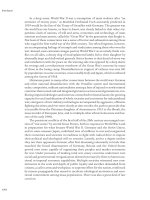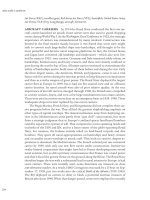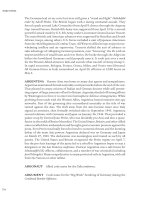The concise encyclopedia of world war II 2 volumes (greenwood encyclopedias of modern world wars) ( PDFDrive ) 464
Bạn đang xem bản rút gọn của tài liệu. Xem và tải ngay bản đầy đủ của tài liệu tại đây (85.59 KB, 1 trang )
Fire Plan
the Mannerheim Line on February 11. Its Finnish defenders were exhausted. After
months of heavy resistance they now ran low on stamina as well as ammunition.
The Finns were thus forced to ask for terms. They signed them on the night of
March 12–13, 1940, in Moscow. Sweden brokered the deal.
With victory, Stalin’s demands went beyond his 1939 claims for territory in
southern Karelia. He also revoked the earlier offer of “compensation” with territory from eastern, Soviet Karelia. Finland instead ceded to the Soviet Union most
of the southern Karelian isthmus, which Field Marshal Carl Gustaf von Mannerheim
had captured in the campaign of 1919–1920 during the Russian Civil War. The
ceded land thereafter formed a widened buffer zone covering the northern approach to Leningrad. Helsinki also surrendered land in central Finland, as well as
lease rights to a Soviet naval base protecting the Gulf of Finland. The Red Army
occupied all surrendered territories, but no more. It even pulled back to the agreed
settlement line where it had overrun it during fighting in the north. Estimates
of Soviet dead range from 126,000 to 200,000, but are not reliable due to Soviet
propaganda interest in concealing the full extent of casualties. Finland’s losses
were about 30,000 dead and 45,000 wounded. The Finns were also left to care for
400,000 refugees and other civilians displaced by the border adjustments.
The apparent weakness of Soviet arms in the Finnish campaign made an impression on Hitler. It may even have hastened his decision to attack eastward before driving Britain out of the war, by reinforcing his belief that Soviet strength was
an illusion and that all he needed to do was “kick in the door” for the Soviet edifice
to fall. The outcome also left all Finns unalterably hostile to the Soviet Union and
determined on ultimate reversal of the forced territorial settlement. On June 25,
1941, Finland therefore launched what it officially called the “Continuation War.”
Its small but excellent armies waited just three days to join the Axis attack against
the Soviet Union launched by Hitler in Operation BARBAROSSA. Thereafter, the
Finns fought on the northeastern flank of the Eastern Front, supported by the Wehrmacht but not sharing its methods or goals of extinction of the Soviet Union. All
the Finns wanted was their national territory back: once they advanced to 1939
frontiers, they stopped.
See also Molotov breadbasket; Molotov cocktail; motti; Soviet Navy; Tripartite Pact.
Suggested Reading: Carl van Dyke, The Soviet Invasion of Finland (1997).
FIRE CONTROL CENTER (FCC)
See artillery.
FIRE FOR EFFECT Artillery term for when a forward observer confirmed that
batteries had found the right range and elevation to the target and were instructed
to maintain continuous fire at their maximum rate to suppress or destroy the
enemy.
FIRE PLAN Using mapped indirect fire, or otherwise “predicted fire,” by one or
more artillery batteries to blast preselected areas or precise targets, rather than
387









